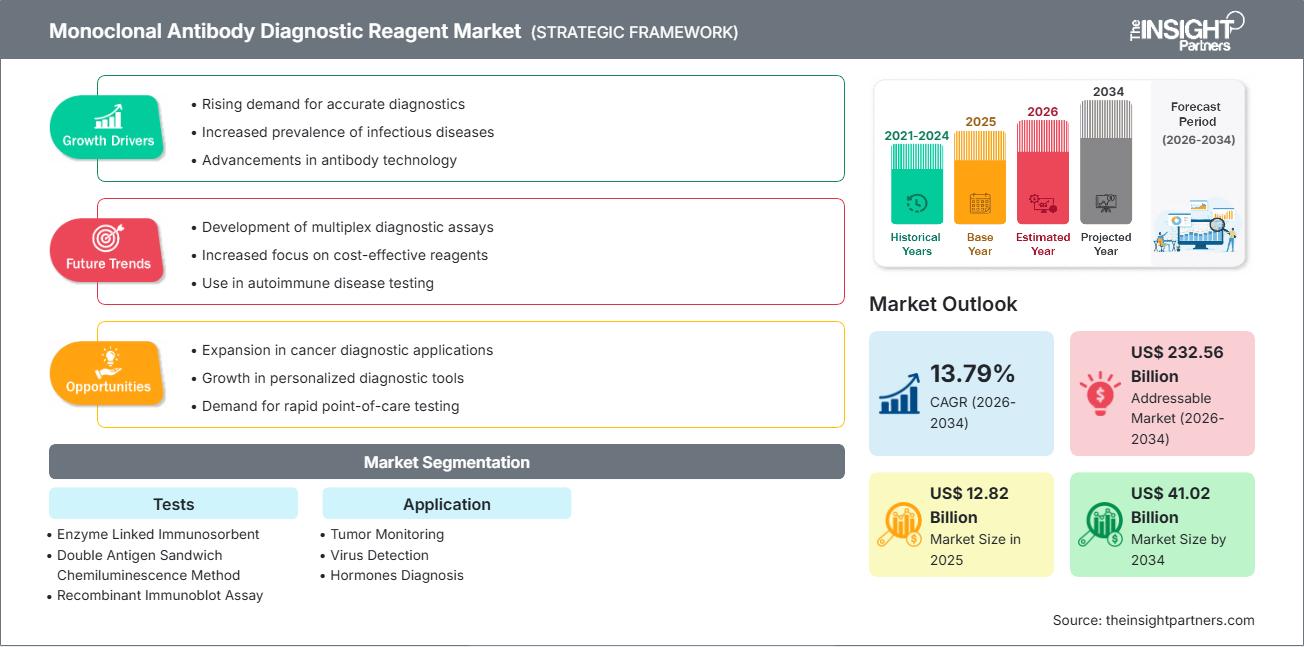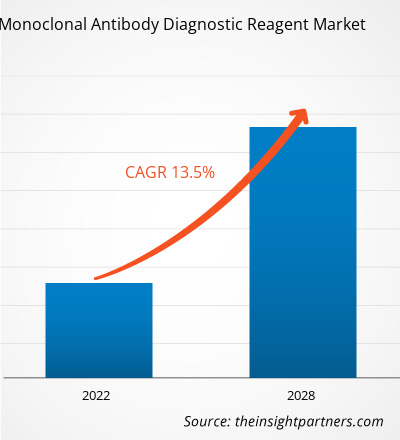单克隆抗体诊断市场规模预计2025年的128.2亿美元增长到2034年的410.2亿美元。预计该市场在2026年至2034年期间的复合年将达到13.79%。
单克隆抗体诊断市场分析
单克隆抗体 (mAb) 诊断试剂市场正经历强劲增长,这主要得益于癌症、自身免疫性疾病和传染病等慢性疾病日益普遍,而这些疾病亟需早期准确检测。单克隆抗体因其对靶抗原(生物标志物、激素或微生物产物)的高特异性和亲和力,成为诊断检测的关键组成部分。这些试剂广泛应用于各种体外诊断 (IVD)生物技术的进步,特别是生产高、高稳定性和低毒性的人源化或人源单克隆抗体的能力,正在加速其在全球临床实验室和研究机构的应用。此外,大规模研发投入开发新型诊断方法,以及大量在诊断研研试剂的,也对市场产生了积极影响。
单克隆抗体诊断市场概述
单克隆抗体是生物医学和微生物学研究中关键的亮点,也是先进诊断检测的关键工具。其原理是利用单克隆抗体结合患者样本(如血液或血液)中的靶标,从而实现疾病标志物的准确鉴定和内涵。由此衍生肿瘤或重组技术的诊断试剂能够进行现代医疗保健所需的大目前,多个诊断实验室采用基于单克隆抗体的检测方法。单克隆抗体可与荧光染料或酶连接,制成免疫组织和酶联免疫吸附试验(ELISA)等技术中枢的工具,有助于疾病的早期发现、治疗效果的监测以及个体化医疗策略的制定。
根据您的需求定制此报告
您可以免费获得任何报告的定制服务,包括本报告的部分内容、国家/地区方面的分析、Excel数据包,以及面向问题企业和高校的优惠折扣。
单克隆抗体诊断市场:战略分析

-
获取本报告的主要市场趋势。一份免费样品将包含数据分析,内容主题市场趋势、提示和预测等。
单克隆抗体诊断市场驱动因素和机遇
市场驱动因素:
- 慢性病患病率上升:全球癌症、自身免疫性疾病(如类风湿性关节炎)和传染病的发病率不断上升,导致人们对早期检测和疾病监测所需的特异性和可靠的诊断工具的需求大幅增加。
- 为开发新型疗法,研发投入巨大:制药和生物技术公司在研发领域的大量投资正推动着新型疾病生物标志物的发现,并进而开发出用于检测这些生物标志物的高特异性单克隆抗体诊断试剂。这其中包括一系列强大的新药和诊断测试产品线。
- 生物技术进步:基因工程、细胞培养系统和蛋白质工程的创新使得开发更有效、高度特异性和免疫原性更低的人类和人源化单克隆抗体成为可能,从而提高了诊断检测的性能。
市场机遇:
- 拓展至新的治疗/诊断领域:单克隆抗体的应用范围正在传统应用之外进行探索,用于诊断神经系统疾病、罕见遗传疾病以及越来越广泛的传染病,从而扩大了市场范围。
- 多重检测技术的日益普及:使用多重检测技术在单个样本中测量多种分析物(蛋白质、生物标志物)的趋势日益增长,这催生了对各种高特异性 mAb 试剂的需求,用于高通量和高效的诊断,尤其是在肿瘤学和传染病诊断领域。
- 个性化医疗的发展:个性化医疗的转变依赖于根据个人分子特征量身定制医疗方案,大量使用 mAb 诊断试剂来检测特定的疾病相关生物标志物。
单克隆抗体诊断试剂市场报告细分分析
单克隆抗体诊断试剂市场份额按各个细分市场进行分析,尽管典型的细分市场与提供的 AI 草案有所不同。
通过测试:
- 酶联免疫吸附试验:由于其可靠性高、灵敏度高、成本效益好,在检测各种抗原/抗体方面占据主导地位(例如,在病毒检测、激素水平检测中)。
- 双抗原夹心化学发光法:一种高灵敏度和定量的方法,特别适用于特定蛋白质的检测。
- 重组免疫印迹分析:用于复杂或确证诊断。
- 点免疫金过滤法:用于快速诊断。
按申请方式:
- 肿瘤监测:占据最大的市场份额,这得益于 mAb 在检测癌症生物标志物以进行诊断、预后和监测治疗反应方面发挥的关键作用。
- 病毒检测:用于诊断肝炎、艾滋病和流感等传染病。
- 激素诊断:用于测量各种激素的循环浓度。
按地理位置:
- 北美
- 欧洲
- 亚太
- 南美洲和中美洲
- 中东和非洲
单克隆抗体诊断试剂市场区域洞察
The Insight Partners 的分析师对预测期内单克隆抗体诊断试剂市场的区域趋势和影响因素进行了详尽的阐述。本节还探讨了北美、欧洲、亚太、中东和非洲以及南美和中美洲等地区的单克隆抗体诊断试剂市场细分和地域分布情况。
单克隆抗体诊断试剂市场报告范围
| 报告属性 | 细节 |
|---|---|
| 2025年市场规模 | 128.2亿美元 |
| 到2034年市场规模 | 410.2亿美元 |
| 全球复合年增长率(2026-2034 年) | 13.79% |
| 史料 | 2021-2024 |
| 预测期 | 2026-2034 |
| 涵盖部分 |
通过测试
|
| 覆盖地区和国家 |
北美
|
| 市场领导者和主要公司简介 |
|
单克隆抗体诊断试剂市场参与者密度:了解其对业务动态的影响
单克隆抗体诊断试剂市场正快速增长,这主要得益于终端用户需求的不断增长,而终端用户需求的增长又源于消费者偏好的转变、技术的进步以及对产品优势认知的提高。随着需求的增长,企业不断拓展产品线、创新以满足消费者需求并把握新兴趋势,这些都进一步推动了市场增长。

- 获取单克隆抗体诊断试剂市场主要参与者概览
单克隆抗体诊断试剂市场份额地域分析
预计北美将主导单克隆抗体诊断试剂市场。这一主导地位的驱动因素包括:领先的生物制药和诊断公司在该地区的强大影响力、先进的医疗保健基础设施、生命科学领域的大量研发投入,以及个性化医疗等先进诊断技术的高普及率。
市场增长轨迹因地区因素而异:
-
北美
- 市场份额:凭借强大的研发实力、先进的医疗保健以及对新诊断技术的快速应用,占据最高的市场份额。
- 主要驱动因素:医疗保健支出高、大型诊断和生物技术公司的存在以及有利的报销政策。
- 趋势:重点关注分子诊断、生物标志物发现以及人工智能/机器学习在诊断中的应用。
-
欧洲
- 市场份额:市场规模庞大,高度重视高质量诊断和严格的监管标准(例如,体外诊断医疗器械法规)。
- 主要驱动因素:政府对医疗保健研究的资助、慢性病的高发率以及合作研究计划。
- 趋势:即时诊断的增长和先进免疫诊断平台的日益普及。
-
亚太地区
- 市场份额:预计将成为增长最快的区域市场,这主要得益于医疗保健基础设施的快速扩张。
- 主要驱动因素:国际和国内企业(尤其是中国和印度的企业)对研发投入的增加、可支配收入的增加以及庞大的老龄化患者群体。
- 趋势:对经济高效的诊断解决方案的需求不断增长,以及政府支持的改善医疗保健服务的项目。
-
南美洲和中美洲
- 市场份额:新兴市场,越来越多的人能够获得先进的诊断工具。
- 主要驱动因素:医疗设施现代化以及公共和私营部门对慢性病管理的投资增加。
- 趋势:进口诊断试剂盒和本地制造合作关系的采用率不断提高。
-
中东和非洲
- 市场份额:新兴市场具有强劲的增长潜力,这主要得益于阿联酋和沙特阿拉伯的数字化转型举措。
- 关键驱动因素:国家战略性数字化和医疗保健战略,以及提高对传染病和慢性病的认识和筛查计划。
- 趋势:大型医院和诊断中心越来越多地采用先进的诊断平台。
单克隆抗体诊断试剂市场参与者密度:了解其对业务动态的影响
单克隆抗体诊断试剂市场竞争异常激烈,参与者包括全球生命科学巨头、专业诊断试剂盒制造商和区域性企业。推动市场竞争的因素是对更高灵敏度、特异性和更快诊断结果周转时间的需求。各公司正积极创新,以巩固市场地位,并满足市场对精准、早期疾病检测工具日益增长的需求。
竞争格局促使供应商通过以下方式实现差异化:
- 专注于开发高特异性重组单克隆抗体和新型偶联技术,以提高检测性能和稳定性。
- 试剂生产商与体外诊断平台提供商建立合作关系,以确保兼容性和市场准入。
- 严格遵守监管标准(例如 FDA、CE-IVD),以确保其产品的可靠性和临床实用性。
机遇与战略举措
- 专注于多重诊断:各公司正在利用先进技术创建诊断组合,该组合可以同时检测多种疾病生物标志物,从而提供全面的患者信息并开辟新的收入来源。
- 新兴市场投资:大型企业正在亚太等高增长地区扩大其分销网络和本地制造能力,以满足不断增长的需求。
- 并购活动:大型诊断公司收购专业数十家公司,将新型预警技术或小众疾病标志物整合到其产品组合中,因此并购活动十分常见。
单克隆抗体诊断市场的主要企业包括:
- BioGenex
- Bio-Rad Laboratories, Inc.
- Biocare Medical, LLC
- Celltrion Healthcare Co., Ltd.
- 创意诊断
- GenWay Biotech
- 赛默飞世尔科技公司
- AB克隆公司
- Apto-Gen
免责声明:以上排名的公司排名不分开头。
单克隆抗体诊断试剂市场新闻及最新进展
- 例如,2025 年 10 月 29 日,全球科学服务领导者赛默飞世尔科技公司宣布达成最终协议,各方 Astorg 和 Nordic Capital、Novo Holding 和 Cinven 等股东集团手中收购了领先的临床试验终点数据解决方案 Clario Holdings, Inc.,交易完成时将于 88.75 亿美元现金支付,未来将根据业绩情况支付额外的盈利能力资助和其他款项。
- 2025年6月23日,领先的抗体、抗体和检测试剂盒制造商和供应商Creative Diagnostics宣布推出其新的人类混合IgM控制单克隆抗体系列,用于研究应用,涵盖CMV、HSV、MeV、MuV、RuV和VZV等多种疾病。
- 2025年6月17日,全球生命科学研究和临床诊断产品领先者Bio-Rad Laboratories, Inc.宣布,其重组单克隆抗独特型抗体产品线新增了针对帕妥珠单抗(Perjeta)、古塞库肿瘤(Tremfya)、卡那肿瘤(Ilaris)、贝利尤单抗(Benlysta)以及双电位药物艾美赛珠单抗(Hemlibra)的抗体。此外,该公司还扩展了其SpyCatcher试剂产品线,新增了人IgM-FcSpyCatcher。
单克隆抗体诊断市场报告主题范围及成果
《单克隆抗体诊断试剂市场规模及预测(2021-2034)》报告对市场进行了详细分析,主要涉及以下领域:
- 单克隆抗体诊断试剂市场规模及预测,涵盖全球、区域和国家方面的所有关键市场解析领域。
- 单克隆抗体诊断市场趋势,以及市场动态,例如驱动因素、否定因素和主要机遇。
- 详细的PEST和SWOT分析
- 单克隆抗体诊断市场分析,涵盖关键市场趋势、全球和区域框架、主要参与者、法规和近期市场发展动态。
- 单克隆抗体诊断市场行业格局及竞争分析,主要市场集中度、热力图分析、主要参与者及最新发展动态。提供详细的公司简介。
- 历史分析(2 年)、基准年、预测(7 年)及复合年增长率
- PEST和SWOT分析
- 市场规模、价值/数量 - 全球、区域、国家
- 行业和竞争格局
- Excel 数据集
近期报告
客户评价
购买理由
- 明智的决策
- 了解市场动态
- 竞争分析
- 客户洞察
- 市场预测
- 风险规避
- 战略规划
- 投资论证
- 识别新兴市场
- 优化营销策略
- 提升运营效率
- 顺应监管趋势






















 获取免费样品 - 单克隆抗体诊断试剂市场
获取免费样品 - 单克隆抗体诊断试剂市场